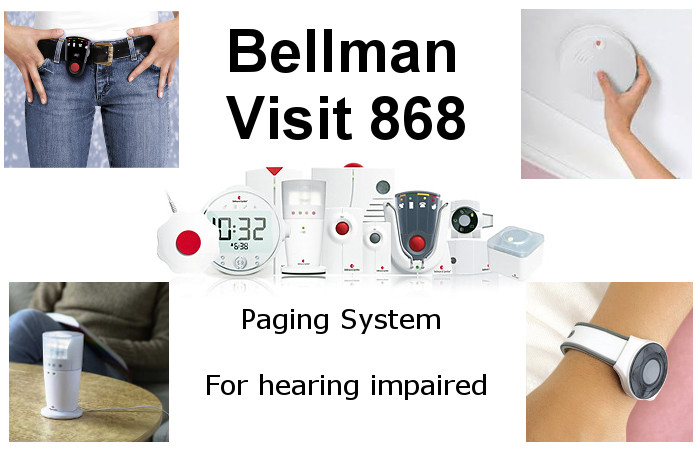Assistive Devices & Equipment
Contents: To jump to the topic you would like, click on the links below
Introduction
An Assistive Device is any device that helps persons with disabilities or Impairments to do something that they might not otherwise be able to do, thus giving that person more independents. Assistive Devices or Assistive Technology can help persons who are Deaf or have Hearing Impairments to be alerted to a noise or communicate if they have a speech, or language disorder and include equipment such as Alerting Devices, Hearing aids, Assistive listening devices (ADL) and Argumentative and Alternative Communication (AAC) Devices. With the development of digital and wireless technologies, more and more devices are becoming available to help people with hearing, voice, speech, and language disorders to communicate more meaningfully and participate more fully in their daily lives.
As there are a wide variety of different types of Hearing Impairments, there are also a variety of different Assistive Devices, options and solutions which are available to be purchased in South Africa from Organizations and Companies such as Edit Microsystems who can also advise you on what equipment would best suit you and your needs and can also offer support to you on how to best use the equipment that they supply. To view more information about these Assistive Devices and the Organizations and Companies that provide them, read the article below or view the menu on the left.
Alerting Devices
Alerting Devices for the Deaf or those with Hearing Impairments, are Assistive Devices that connect with door bells, telephones, alarm systems and other devices, to let a person know that some condition is occurring, such as a smoke alarm, door bell ringing or baby crying. These Alerting Devices add a specific alarm based on one's disability, such as a door bell that blinks a light instead of a noise to indicate that someone is at the door. These Alerting Devices are supplied by Organizations and Companies such as Edit Microsystems, can include, but are not limited to:
telephones, alarm systems and other devices, to let a person know that some condition is occurring, such as a smoke alarm, door bell ringing or baby crying. These Alerting Devices add a specific alarm based on one's disability, such as a door bell that blinks a light instead of a noise to indicate that someone is at the door. These Alerting Devices are supplied by Organizations and Companies such as Edit Microsystems, can include, but are not limited to:
- Specially designed phones
- Smoke and carbon monoxide detectors
- Doorbell alert
The alerting technology includes Flashing Lights; Vibration or Extra Loud Alarms. Hearing Dogs can also assist their owner by alerting them to these noises or dangers.
Hearing Aids
Hearing Aids are devices used by partially deaf individuals to regain a portion of hearing by amplifying sound. They work to improve the hearing and speech comprehension of those with hearing loss. It works by magnifying the sound vibrations in the ear so that one can understand what is being said around them. The use of this technological device may or may not have an effect on one's sociability. While some people feel as if they cannot live without one because they say it is the only thing that keeps them engaged with the public, others dislike Hearing Aids and avoid hearing aid usage altogether and would rather remain quiet and to themselves in a social environment. Auditory-verbal therapy (AVT) or auditory-based therapy — is a type of early intervention therapy for young children who are deaf and hard of hearing, or those who use hearing technology such as hearing aids or cochlear implants.
Read More....
Hearing Dogs & Equipment
A Hearing Dog or Alert Dog is an Assistance Animal which assists persons who are Deaf or those who have Hearing Impairments in various ways. Assistance or Service animals are defined as animals that are individually trained to do work or perform tasks for persons with disabilities, they are working animals and not pets, so the work or task that the animal has been trained to provide must be directly related to the person's disability.
Hearing Dogs are Assistance Dogs which have been specifically trained to assist persons who are deaf or hard of hearing by alerting their handler to important sounds, such as doorbells, smoke alarms, ringing telephones, or alarm clocks. Hearing Dogs can replace the need for other Alerting Devices used in the home but may also work outside the home, alerting their handler to sounds such as sirens, forklifts and a person calling the handler's name.
Training of these various types of Assistance Dogs is provided by Accredited training companies and organisations such as The Smart Dogs Training Centre, Paws4life Training Academy, Honey’s Garden For Medical Alert Dogs SA and The S.A. Dog Training College. Through this training that they receive from these companies and organisations, they will learn how to provide assistance to their handler and the handler will be required to train with their dog to learn how to communicate with their Assistance Dog.
Real-time Text Technologies
Real-time text technologies, involving streaming text that is continuously transmitted as it is typed or otherwise composed. This allows conversational use of text. Software programs are now available that automatically generate a closed-captioning of conversations. Examples include discussions in conference rooms, teleconference calls, classroom lectures, and/or religious services. These Devices are sold by Organizations and Companies such as Edit Microsystems and include products such as the UbiDuo 3 Text to Speech 1 – Communication Device w/ Speech.
Sign Language & Interpreters
Sign language is a language which chiefly uses manual communication to convey meaning, as opposed to acoustically conveyed sound patterns. This can involve simultaneously combining hand shapes, orientation and movement of the hands, arms or body, and facial expressions to express a speaker's thoughts. Sign languages share many similarities with spoken languages, which depend primarily on sound, which is why linguists consider both to be natural languages. There are however some significant differences between signed and spoken languages, such as how they use space grammatically, sign languages show the same linguistic properties and use the same language faculty as do spoken languages. They should not be confused with body language, which is a kind of non-linguistic communication.
Wherever communities of deaf people exist, sign languages have developed, and are at the cores of local deaf cultures. Although signing is used primarily by the deaf, it is also used by other people who can hear, but cannot physically speak.
It is not clear how many sign languages there are. Aside from the pidgin International Sign, each country generally has its own, native sign language, and some have more than one (although there are also substantial similarities among all sign languages). The 2013 edition of Ethnologue lists 137 sign languages. Some sign languages have obtained some form of legal recognition, like in South Africa, while others have no status at all.
In linguistic terms, sign languages are as rich and complex as any spoken language, despite the common misconception that they are not "real languages". Professional linguists have studied many sign languages and found that they exhibit the fundamental properties that exist in all languages. Today, linguists study sign languages as true languages, part of the field of linguistics.
A common misconception is that sign languages are somehow dependent on spoken languages: that they are spoken language expressed in signs, or that they were invented by hearing people. Sign languages, like all natural languages, are developed by the people who use them, in this case, deaf people, who may have little or no knowledge of any spoken language.
As a sign language develops, it sometimes borrows elements from spoken languages, just as all languages borrow from other languages that they are in contact with.
Telecommunication Aids
Persons who are Deaf or have Hearing Impairments can communicate by telephone using certain types of Telephones and Assistive Devices known as Telecommunication Aids. There are a wide variety of different types of this equipment available, including Text Telephones; Telephone Typewriters (TTY); Videophones and Amplified Telephones. Alerting Devices are also available to Alert persons who are Deaf or have Hearing Impairments, so that they are aware when their telephone is ringing. Software Apps are also available to provide assistance on mobile phones. You will need to choose a Telecommunication Aid to suite your needs & preferences, so that you can remain as independent as possible. Thankfully, there are various Organizations & Companies such as Edit Microsystems, which offer a wide variety of these Telecommunication Aids and can also advise you on which Telecommunication Aids would best suit your needs and how to use the equipment that they supply. To find out more about these Telecommunication Aids that can assist you, click the "Telecommunication Aids" button on the left or the link below.




